Nomita Khatri
This paper explores the relationship between the sky and land in my home state of Goa, India at the onset of the Indian monsoon. Using a phenomenological and reflexive approach I regularly spent time observing the sky at different points as I went about my day, journaling my experience and photographing it over a period of two months. I then analysed the themes that emerged in the context of German philosopher Martin Heidegger’s (1889–1976) notion of “dwelling,”; Alexandra Harri’s comment on Gilbert White’s idea of being attentive to the weather through the senses and it’s ability to have “agency” on us as described by Christopher Tilley and Bruno Latour. I found that my experience “under-sky” urged me to find expansiveness both outside and within. By encountering the sky as it was I gave myself permission to be present to whoIwas being in the moment too.
Introduction
This paper is a report on the sky journal I kept in June and July 2018 in Goa, observing the wind, clouds, sun and the mildness – or not – of the weather as the Indian monsoon was beginning and ripening to its fullest: this was the hinge as the seasons change. As part of my investigation I explore Martin Heidegger’s concept of ‘dwelling’, outlined in his 1971 essay ‘Building, Dwelling, Thinking’, applying it to life under the monsoon sky of Goa, in the semi-urban neighbourhood where I live. I also looked at Bruno Latour and Christopher Tilley’s notion of ‘agency’, together with and Alexandra Harris’s observation of Gilbert White’s phenomenological response to the weather.
My Method: Phenomenology and Reflexivity
I relied on two methodologies: phenomenology and reflexivity. In the reflexive method narratives through stories are understood in the context of lived experiences and the meanings they create. I am an Indian woman who has just observed my thirty-seventh monsoon from the western coastal state of Goa, India, where I now live. I grew up predominantly in large metropolises around India in a middle class dual-religion (Catholic/Hindu) family. My interest in bio-dynamic farming took me to live, learn and work in semi-rural and rural places, while my professional work as a graphic designer incorporated more of the themes of connecting with the earth, water and sky. Through these experiences, I deepened my understanding of the web of connection in which we live, reflecting both the urban and rural perspectives I have developed.
As Kim Etherington comments, ‘as human beings we learn a great deal from re-telling stories, creating new meanings and deepening existing ones’ while being mindful of ‘our own ideology, culture and politics and that of our participants and audience’.[1]I have looked at ‘stories’ told during the monsoon period in the form of festivals and rituals, including my experience as a researcher as I considered the sky allowing it to reveal new subjective meanings and a sense of self and identity, negotiated as the stories unfolded. My own experience then becomes part of the narrative. Also, in effect, I was interviewing the sky, engaging with it as fully as I could, as a multi-sensory component. This was the phenomenological part of my research, engaging directly with the phenomena around me. Maurice Merleau-Ponty sees phenomenology as the essential contact point between consciousness and environment.[2]He talks about phenomenology as a ‘philosophy for which the world is always ‘already there’ before reflection begins… and all its efforts are concentrated upon re-achieving a direct and primitive contact with the world… that does not expect to arrive at an understanding of man and the world from any starting point other than that of their facticity.[3]Laura Sewall adds to this idea when she says, ‘focused attention produces a richness of colour, a depth of sensory experience and often means the difference between seeing and not seeing’.[4]For me, inhabiting the sky relied on the use of all my senses, including sound and smell as well as sight. I paid particular attention to the sensual cues presented in my observations, and spent time observing the sky to see what Sewall’s ‘focused attention’ brought to my consciousness.
When there was pause in the rain, which there was most days in the two month period, I walked outside and took photographs on my phone, recorded my sensory observations in a journal. I paid attention to what each of my presented to me, along with anything else which particularly drew my attention.
Literature Review: Being and Dwelling
In his essay ‘Building, Dwelling, Thinking’ Martin Heidegger traces the root of the English word ‘building’ to the Old English word bauen, meaning to dwell. ‘Dwelling’, in turn, comes from the Gothic wunianand is itself related to the German bauen, which is ‘to dwell’ Bauenalso signifies to ‘stay in place’ or ‘remain’ whereas, wunian specifies how this is to be experienced, ‘to cherish and protect, to preserve and care for, specifically to till the soil, to cultivate the vine’.[5]Therefore bauen means ‘to stay in one place’, while ‘being at peace’ to be ‘safe guarded from danger.’Heidegger belived that, ‘the fundamental character of dwelling is this sparing and preserving’(emphasis in the original).[6]This kind of attention or ‘dwelling’ allows entities to become or be themselves without having to be more than they already are.
To extend the concept of ‘preserving, for me, to ‘preserve’ the earth means to be under the sky, which also means ‘remaining before the divinities’ and includes a belonging of mortal to mortal. Thus, by a ‘primal oneness,’ earth, sky, divinities and mortals belong to together. In Heidegger’s opinion, ‘when we say sky, we are already thinking of the other three [Earth, Divinities, and Mortals] along with it, but we give no thought to the simple oneness of the four’, which he calls the ‘fourfold’ .[7]To understand how to ‘dwell’ in this peaceful way, by Heidegger’s definition, is to understand a human being’s place within the fourfold. It is through this lens and the study of the sky that I unpack Heidegger’s concept of the ‘fourfold’.
The phenomenology of weather was experienced by ‘dwelling’ in it through my senses – sight, hearing, smell and feeling. Alexandra Harris, commenting on Gilbert White’s attentiveness to the weather, wrote, ‘White could never be content with statistics alone. He also had to look and touch and smell the air to understand how this familiar environment was altered’.[8]To follow White and Harris, if I were to experience the fundamental character of ‘dwelling’, I had to rely on focused sensual experience in order to expand my awareness. Also, to inhabit the sky, is to be impacted by it. Agency, as described by the French social-theorist Bruno Latour and the British archaeologist Christopher Tilley, is the equal ability for things and people to have an impact on each other propelling them into action. As Tilley wrote, objects ‘create people as much as people make them’.[9]In my research Tilley’s objects were in the sky, and the ones in my sky were the wind-borne monsoon clouds and the sun, all of whom exhibited ‘agency’, impacting on me, the earth and the cultural rhythms that define this time of the year.
Fieldwork and Discussion
Once I had written my Sky Journal, I was able to analyse it into three themes, each exploring an aspect of ‘dwelling’which emerged over the course of the observational period. Each section includes some of my observations, as well as the myths, and other academic insights that wove their way into my experience during this time.
Theme 1: Myth and Ritual in ‘Dwelling’
On 17 June, 2018 I wrote:
I am enjoying the fresh smell of damp earth, after months of heat, dust and dry weather. The sky in the west looks an ominous purple-grey and I hear distant thunder. I watched mesmerised by the contrast in colour between sky and land (see Figure 1). The wind blew in rain-heavy clouds, sweeping them over where I stood, still watching, mesmerised. I finally seek shelter as it begins to pour. While I stand under a sliver of tin roof, slowly getting soaked, I think of the monsoon myth.
Situating this experience and observation in the context of the mythology of the sky, the Vedas, which are a collection of hymns and other ancient religious texts written in India between 1500 BCE and 1000 BCE, speak of the arrival of the monsoon as a war between Indra, God of rain, warrior of the peopleand Vitra the demon.[10]Having taken all the waters of the earth, Vitra has placed them in a mountain and stood guarding it, causing drought and famine. Indra decides to fight Vitrato free the waters with his weapons – the thunderbolt and lightening. The battle concludes withIndrafatally wounding the demon Vitra, freeing the waters that bring back life. Since then, the sound of a gathering storm indicates the presence of Indra. Examining this myth in the context of my phenomenological experience affirms Heidegger’s understanding of the verb ‘to dwell’, that is, to live, by ‘preserving’ and ‘sparing’ in the ‘simple oneness of the ‘primal oneness,’ earth, sky, divinities and mortals.[11]It was as if the ancient myth came alive in my experience.
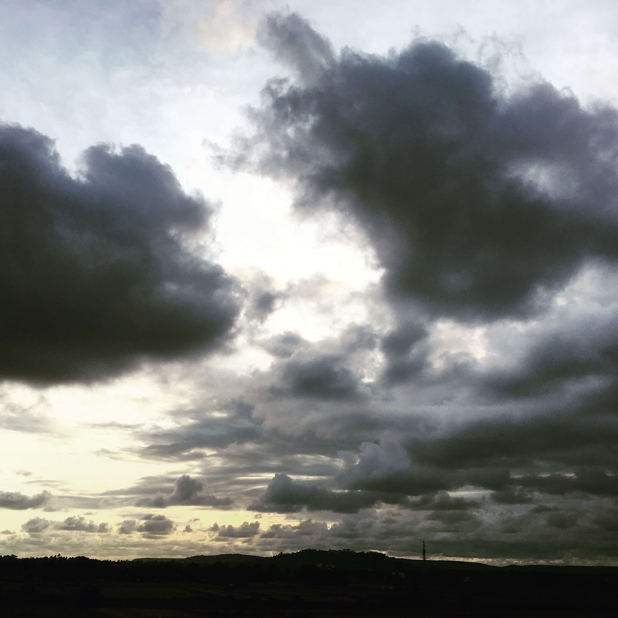
The expression of experiencing the ‘essence’ of the arrival of the monsoon, is turned into a local ritual of celebration and thanksgiving on 24 June, which is also the feast of Saint John the Baptist. The festival of São João is celebrated traditionally when young men go from house to house seeking a dip in the family well to be given gifts of the earth, the local seasonal fruit and a sip of the local alcoholic cashew drink, fenias an expression of thanksgiving.[12]The day is also marked by making tiara’s called koppels made out of the season’s flowers and leaves. By dwelling on the weather-myth in my first drenching of the season, I felt appreciative of the nuanced connections to the ‘fourfold’ in the form of the São João ritual. As an annual reminder, it illustrates Heidegger’s idea of dwelling by embodying it into lived experience. Sky, earth, mortals and divinities are intrinsically linked by the coming of rain, in a natural phenomenon that is experienced year after year allowing the sky to belong to what Tim Ingold called ‘the world that people inhabit’ just as the earth we tread on.[13]
Theme 2: Dwelling Within and Without
For the majority of this research project I remained, to use a Tennysonian invention, ‘under-sky’ that is, under cloud-cover.[14]My internal response to the churning of the monsoon sky was split. The gardener in me cheered at the dripping skies, which signified a time of ripeness, fertility and plenty. The urban woman in me at first exulted in it, ‘learning to feel the level of damp or dryness in the air, as a gauge of whether or not to run errands on a scooter.’ As the monsoon progressed I dwelled with feelings of ‘claustrophobia’, a ‘sense of confinement’ and ‘gloom.’ In a journal entry from 20 July I observed, ‘riding a scooter means to be open to the elements and hence needing to live by its rhythm. The downside is that it restricts my freedom of movement in the way having the car-on-loan simply does not.’
When I did step outside, I noticed myself seeking a sense of space by riding towards open expanses or quite old neighbourhoods with their still-dense tree cover to walk in, steering clear of the urban sprawl. Phrases from my journal illustrate this until now, unconscious choice, ‘the fields in front of me feel soothing to the spirit this evening’, ‘the forest to my right makes a dark green wall that reaches up to the sky’, which is when it struck me — the experience of expansiveness that Shelley had found in the sky I had unconsciously been seeking ‘under-sky’, only to understand that it was available in wide expanses and the subtly different, shades of green (see Figure 2).[15]That coupled with the almost constant battering rain slowed the pace of life to a crawl, allowing long stretches of solitary time in which to contemplate how I ‘dwell’ with myself.
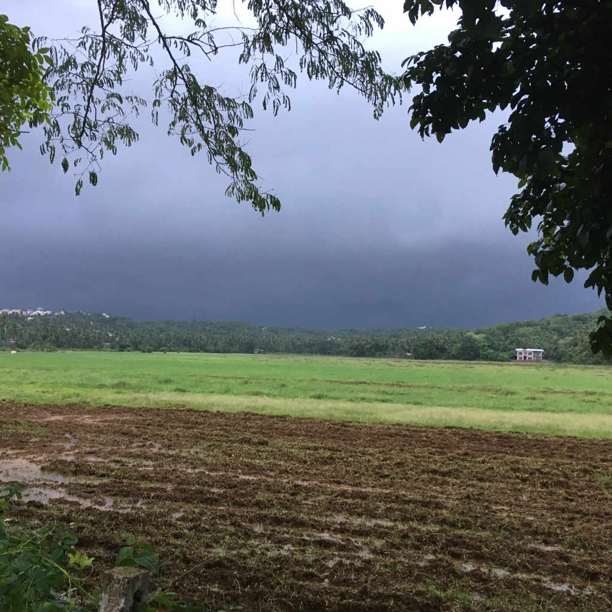
In a journal entry dated 30July 2018, when I chose to walk a part of the neighbourhood I was unfamiliar with I observed:
An old laterite (stone) house with its tiled roof completely caved in — a house that is reclaiming the sky! All manner of greenery, with impetus from the heavy rains, no doubt, are simultaneously reclaiming the stone. Two seats, part of what would have been a roofed in verandah, still sit conversationally facing each other.
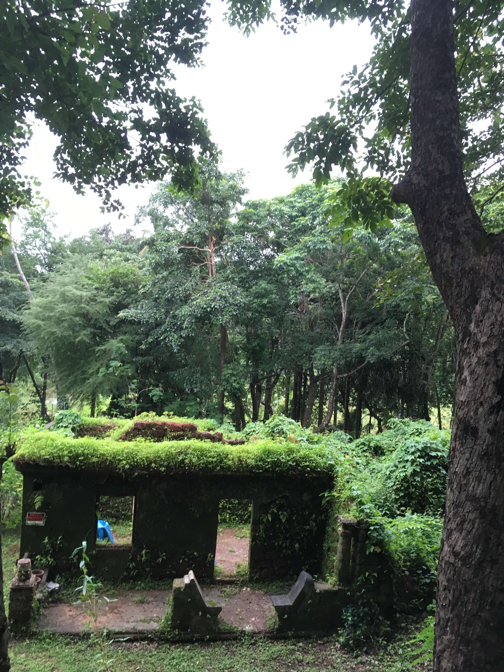
Roszak, Gomes and Kanner, commenting on Laura Sewall’s approach to phenomenology, state, ‘Perceptual psychologist Laura Sewall points out that our sensory capacities — taste, smell, sight, hearing and touch are the fundamental avenues between self and world’.[16]This former building (see Figure 3) in its crumbling form exhibits ‘dwelling’ in that it is becoming itself by ‘reclaiming sky’ and being reclaimed by the earth. In being itself in the moment I encountered it, it seemed to give me permission to be who Iwas in that moment too — presence begetting presence.
Theme 3: Dwelling ‘Under-Sky’
A small percentage of the local population leapt into action, in a time-honoured tradition of tilling the land, emphasising French social theorist Bruno Latour’s concept when he says that an object has agency when it, ‘has the ability to move us to take action’.[17]An excerpt I wrote on 12 July 2018 exhibits this agency with the onset of the monsoon:
Plastic-encased human figures stoop in ankle deep water on communidade(the Portuguese word for community) land, transplanting paddy… I see another semi-transparent wall of rain in streaks of grey obscuring the bucolic planting scene (see Figures 4, 5 and 6). The figures continue to dig, sow and transplant as the rain batters down.
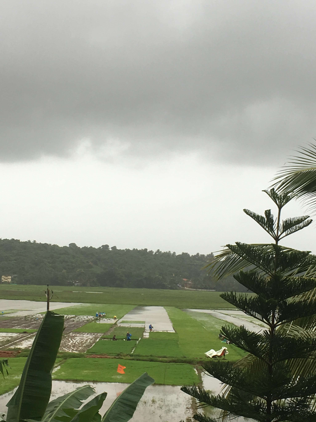
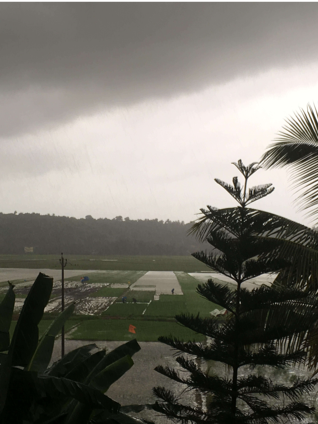
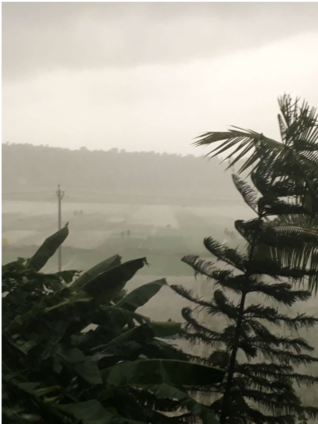
Photos: Nomita Khatri
The earliest record of the sky as agent appears as early as 700 BCE when the Greek poet Hesiod urges his brother Perses in the poem Works and Days toplough the field ‘when the Pleiades and Hyades and strong Orion begin to set’.[18]Turning again to Heidegger, as we receive the churning sky in ever-changing shades of grey, the earth below changes visibly in response to mortals ‘tilling the soil’ or ‘sparing’ it, nurturing it into a vibrant patchwork of psychedelic greens that exhibit the ‘fourfold’ and our place as mortals within it.[19]Rain is a key ingredient of the making of humanity, in the classical tradition too, as is evident in the sensuous description of the birth of rain in this passage from Virgil’s Georgics, cited in Harris’ ‘almighty father, Air, marries the Earth and penetrates her with prolific showers, and, their bodies joined as one, unbridles life’s potential’.[20]
Harris describes the concept of being ‘weathered’.[21]We can be ‘weathered’ by life in the fourfold, which gives us much to contemplate if we stay present to the outcomes of experiencing it in its windy and fierce glory, even when it comes into destructive contact with human development. For example, an almost routine component of my research has been the experience of power outages and resulting regular disruption. Trees have fallen on electricity lines and been brutally felled, canals have flooded and poorly built bridges collapsed. By bringing ‘focused attention’ to the sky I was able to see the ways in which we choose to control the earth, to ‘build’ in the most restrictive sense of the word and hence to spoil rather than ‘preserve.’ Just like White and Heidegger, paying conscious sensuous attention to the weather meant an insightful connection to it, in both its beautiful and destructive aspects.
Final Thoughts
At the time of completing the writing of this essay at the end of August 2018, torrential monsoon rains continue to lash the coastline from where I sit. Paying focused attention to the objects in the sky had become a sort of ritual for the duration of the research. To ‘dwell’ in the sky meant to ‘dwell’ on myself with a deepened ability to see the connections within the ‘fourfold.’ By extension, the weather-myths and rituals we’ve created serve as a ritual reminder of the interconnectedness within which we live — a connection that is alive in the agrarian community I witnessed during my research.
Urban life, on the other hand, as noticed from witnessing a part of myself, is increasingly removed from this interconnection. As I observed, simply not having a car meant I had to learn to pay attention to the wind-speed, shade and tone of the clouds on the horizon in order to gauge how long I had between squalls. Paying conscious sensuous attention to the weather meant a connection to it, which expanded my awareness of its impact. This repeated awareness of my place with respect to the sky was dulled, when I had brief access to a closed vehicle. The larger these leaps away from experiencing the forces of nature, the deeper our sense of loss and a lack of awareness of the web of interconnectedness within which we live and always have. Ritual in this context becomes a meaningless sequence of repetitive acts devoid of meaning. The delusion that we have control over the physical environment that we find ourselves in perpetuates, even as we increasingly make choices that reflect our increasing disassociation with it and hence ourselves.
Conclusion
The aim of this research project was to examine the sky by recording observations made through the senses: sight, touch, sound and smell, compiled in the months of June and July 2018 in a semi-urban neighbourhood in Goa. I took a reflexive approach, reflecting my own position, and a phenomenological one, attempting to engage as directly with the phenomena around me as I could. By choosing this approach to study the sky, the door was opened for me to observe and record at multiple sensuous levels and I explored my findings in relation to Martin Heidegger’s notion of ‘dwelling’ within the ‘fourfold’. Chris Tilley, Tim Ingold and Alexandra Harris also helped me focus on being in place and time. Maurice Merleau-Ponty’s ideas formed the connection between the theoretical framework and my experience with the sky and my consciousness. I was truly ‘weathered’. To conclude, I will return to my experience of watching the purple-grey clouds stacked atop one another at the beginning of the monsoon. As I watched the clouds glide over me, caught up in the sheer beauty of it, I forgot to seek shelter, getting drenched in the bargain. An insightful learning that I unpacked in the following weeks emerged — the knowing that for better or for worse we are bound to and are intrinsically connected to the cycles of this planet; a simultaneously frightening and liberating thought. It was frightening to notice the increasing disconnection between the Earth, the ball of matter we inhabit, and the sentience on which we are so completely dependent upon in order to thrive. It was liberating because, in the experience of staying present to the sky with attention, I was able to see the huge impact that we too have as agents within the ‘fourfold’, to remedy this disconnection and all the possibilities that entails.
[1]Kim Etherington, Becoming a Reflexive Researcher: Using Ourselves in Research(London: Jessica Kingsley, 2004): pp. 7 and 36.
[2]Maurice Merleau-Ponty, The Phenomenology of Perception, trans. Routledge and Kegan Paul (London: Routledge, 2005 [1945]), p. 73.
[3]Merleau-Ponti, Phenomenology of Perception,p. vii.
[4]Laura Sewall, ‘The Skill of Ecological Perception’ in T. Roszak, M. E. Gomes and A. D. Kanner (eds.), Ecopsychology: Restoring the Earth, Healing the Mind (San Francisco: Sierra Club Books, 1995):pp.201-215.
[5]Martin Heidegger, ‘Building, Dwelling, Thinking’ in Poetry, Language, Thought(1971) at http://ssbothwell.com/documents/ebooksclub.org__Poetry__Language__Thought__Perennial_Classics_.pdf [accessed 3 July 2018]. pp.145 -147.
[6]Heidegger, ‘Building, Dwelling, Thinking’, p.147.
[7]Heidegger, ‘Building, Dwelling, Thinking’, p.147.
[8]Alexandra Harris, Weatherland: Writers and Artists Under English Skies(London:Thames and Hudson, 2016): p.210.
[9]Christopher Tilley, Metaphor and Material Culture (Oxford: Blackwell, 1999): p.76.
[10]British Museum, Indra and the Monsoons (2002) at www.ancientindia.co.uk [accessed 10 August 2018].
[11]Heidegger, ‘Building, Dwelling, Thinking’, pp.145–147.
[12]H. Vadlamani, 2016. ‘Across Goa, youth are jumping into wells today to celebrate the Sao Joao monsoon festival’ (2016) at https://scroll.in/article/810545/across-goa-youth-are-jumping-into-wells-today-to-celebrate-the-sao-joao-monsoon-festival [accessed 10 August 2018].
[13]Tim Ingold, ‘Earth, Sky, Wind and Weather’ in The Journal of the Royal Anthropological Institute, vol.13 (2007): p.S25.
[14]Harris, Weatherland, p. 288.
[15]Harris, Weatherland,p. 288.
[16]Sewall, ‘Skill of Ecological Perception’, pp. 201-215.
[17]Bruno Latour, Reassembling the Social: An Introduction to Actor-Network-Theory(Oxford: Oxford University Press, 2005): pp. 63-86.
[18]Hesiod, ‘Works and Days, in The Homeric Hymns and Homerica, including ‘Works and Days’ and ‘Theogonis’,trans. Hugh G. Evelyn-White, (Cambridge Mass.: Harvard University Press, 1917), lines 609-617.
[19]Heidegger, ‘Building, Dwelling, Thinking’,pp.145 -147.
[20]Virgil, Georgics, 2:325-27 cited in Harris, Weatherland, p.94.
[21]Harris, Weatherland,p.114.
Great thabnks